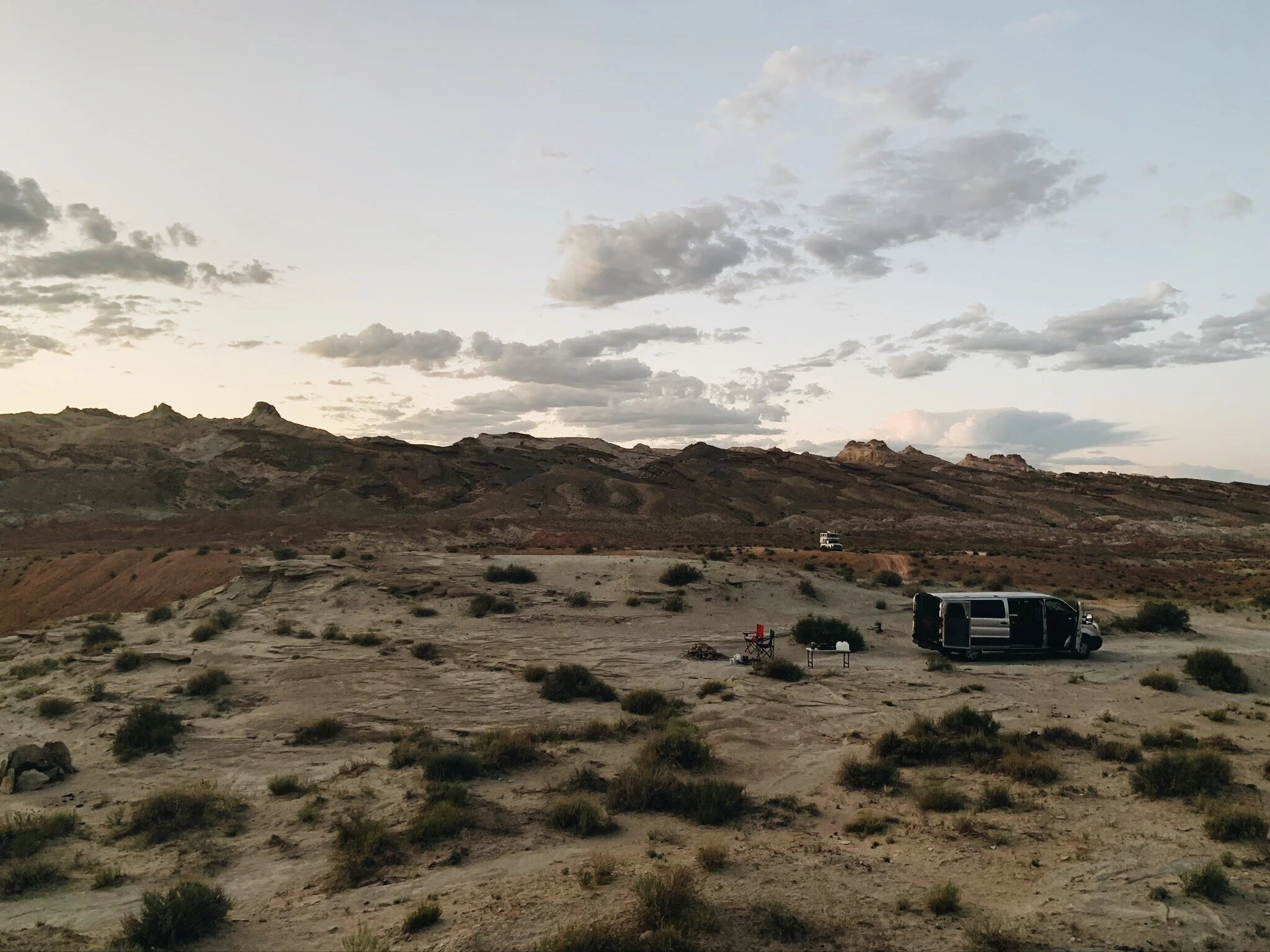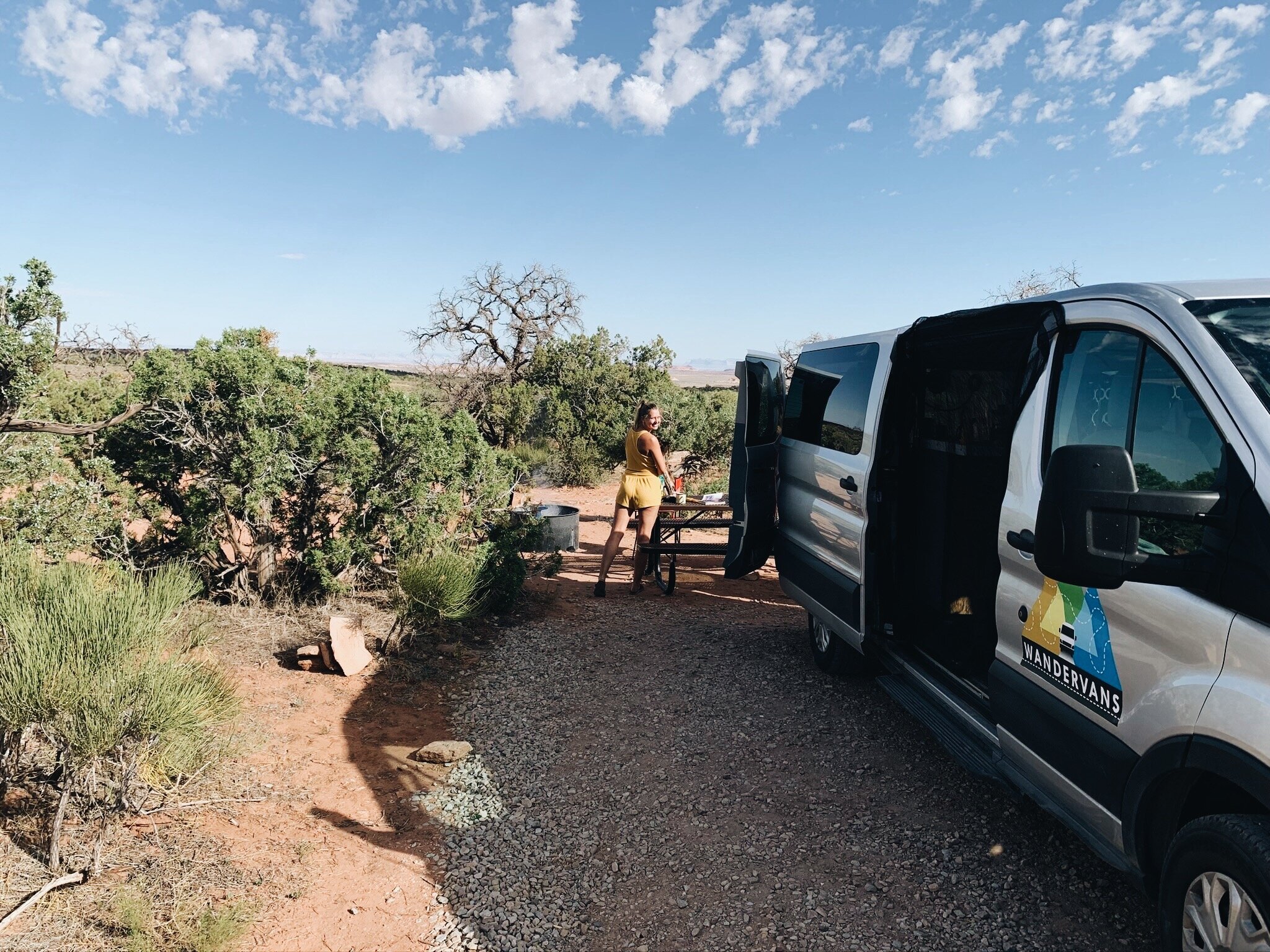Free. Camping. Two beautiful words smashed together if you ask me. As wonderful as it sounds, however, finding free campgrounds around the US can feel overwhelming when you don’t know where to start. Can I just pull over on the side of the road? Is true that you can camp for free in national forests? Will I have to shovel my poop? (Seriously.) Dispersed camping, a fancy naming convention for free camping is an epic adventure and unlocks areas of America that you might never have tapped into otherwise.
When I first started researching for a camper van trip, I started seeing more and more about this dispersed camping. You mean, there is land around America where you can just show up - THAT NIGHT - and grab a free camping spot? I was hooked by the idea but also haunted by new and intimidating it sounded. Western USA is the ~It~ spot for dispersed (or BLM) camping. I was road tripping around Utah; there was no question that I had to incorporate this adventure into my trip.
For those looking to push themselves deeper into the wild, boondocking brings untouched beauty to your doorstep. How? We’re talking about setting up camp in some of the most desolate, beautiful landscapes in the country for goodness sake. AND! For free (or next to nothing)! When it comes to getting in touch with the great outdoors, dispersed camping is one of the coolest natural experiences you can have. While rewarding, researching US boondocking campsites can be daunting, and yes, a bit nerve-racking. I scoured the internet and then put those free camping tips to the test to compile this all-encompassing guide to dispersed camping. Enjoy this insider info that will take your camping travel to the next level.
We cover the basics of boondocking in this article, answering questions like:
What is Dispersed Camping?
How do I find free campsites around the US?
What can I expect in terms of amenities when it comes to BLM campgrounds?
Can I reserve a campground prior to arrival?
WHAT IS DISPERSED CAMPING?
Let’s start with the lingo. When looking for free campgrounds, there are a few different options you should be plugging into the google machine. First BLM or Bureau of Land Management. These are the sites hosted in national forests or on government land. While rarely publicized, it’s actually legal to camp in portions of many of the national forests around America for free or a small fee. Usually when you start seeing ‘No Camping for Blank Miles” it means you’re getting close to a campground. BLM campgrounds tend to be well kept and may come complete with more amenities in exchange for a nightly charge or $20 or less.
Free camping can also be called dispersed camping or boondocking. I’m convinced it’s to keep the crowd away. Nothing to draw people in that stamping the word free on it, right? Usually, when it’s labeled a dispersed campground, the experience will be entirely free with the condition of cleaning up after yourself and limiting the stay to 14 or less.
HOW DO I FIND FREE CAMPSITES AROUND AMERICA?
This is where the majority of my pre-arrival research flooded into so my tips on boondocking sites here will be especially meaningful here because they were put to the test. The website FreeCamping.net was by far the most helpful when it came to scoping the scene. I was hesitant at first because the domain just seems…too easy, but it really was! It reminds me of a 90s version of Airbnb with local listings with varying prices and amenities. All you need to do is type in your location and zoom in on the map. You can click on the icon to read more about the campground, complete with ratings and reviews from other campers to get a better grasp of what to expect.
I also spend a ton of time just googling “Dispersed camping near BLANK” and clicking around to see what commonalities would keep popping up. If you’re planning on heading to a national park on your journey, feel free to ask a park ranger about the best BLM or dispersed campgrounds near you. The sites recommended will tend to charge a small fee as they are apart of managed national forests.
With no shortage of open spaces, Western America is a hotbed for cool dispersed campgrounds. You can end up anywhere from alongside a stream in the woods to the middle of the desert with the full moon blasting down on you. With plentiful options, the west is a wondrous place to start your dispersed camping journey.
WHAT CAN I EXPECT WHEN IT COMES TO DISPERSED CAMPING AMENITIES?
The cool thing about dispersed camping is that it’s still just camping and camping is camping. Ya know? Peeing in the woods, bugs all around, little to no light, all that fun stuff. BLM campgrounds tend to be better kept with clear cut campground sites for each group. I encountered a variety of different available amenities depending on the site. When it comes to bathrooms, we never had access to a sink or shower but we had a pit toilet (non-flushing toilet leading to a hole in the ground). Just the glamorous stuff. One of our campgrounds had a community port-o-potty.
Every single site we visited around Utah had fire rings for campfires at night and were permitted so long as used in the ring to prevent wildfire spread. That said, most of the free campgrounds did not allow the gathering of wood to help preserve the natural environment so if you’re planning on a campfire, be sure to grab some wood from a gas station when you find yourself in town. Those rules will be stamped clearly on the welcome sign so if you’re not sure, check there.
Last but not least, at some of the BLM campgrounds, a picnic table came with each campsite. I can’t understate how nice having a table was if not just for unloading a bunch of our stuff from the van to free up some space. Cooking can be made worlds easier with a table.
Other than toilets, tables, and fire rings, you’ll be on your own when it comes to boondocking so make sure you pack everything you’ll need out in nature. Also worth noting is the lack of cell coverage I had in 80% of these spots.
CAN I RESERVE A FREE CAMPGROUND PRIOR TO ARRIVAL?
The short answer is no, but you can always check to see where reservations are available. When it comes to dispersed camping, the areas are first come first serve which was a horrifying concept to me when it came to planning. WHAT IF WE SHOW UP IN THE DARKNESS AND NO SPOTS ARE LEFT? When it came down to execution we had zero issue finding spots and we were traveling over the fourth of July weekend around Utah. So I think it’s safe to leave your planning hesitations at the door.
Once you arrive at say, a paid BLM campsite, you should spot a little campground number labeled on each site and a sign and pay-box near the entrance. This is why you must remember to travel with cash! You’ll just grab a little envelope from the pay-box, fill out the details along with the campground you’ll be staying, pop in the cash and drop it in the box. Usually, these signs have a list of rules and regulations for the area as well which is always helpful.
When it comes to long term stays at the same site, if you’re staying in the vehicle that is also well, your vehicle to explore, I noticed a few different campgrounds where people left things on the picnic table to make it clear the site was still occupied. Dispersed camping can be a little different as oftentimes, its just a plot of open land where you can pull up and park wherever you please, making it much easier to create a spot if there isn’t one.
Have more tips on boondocking around America? Send them our way at talesofexploration@gmail.com.




